31-NGN开局指南工程师培训胶片ISSUE1.0
初级工程师培训计划

初级工程师培训计划一、培训目标:本培训计划旨在通过系统的培训,帮助初级工程师掌握相关领域的基本知识和技能,提高其专业水平和工作能力,为其未来的工作发展奠定坚实的基础。
二、培训内容:1.理论知识学习初级工程师需要掌握的理论知识包括但不限于:- 工程基础知识:包括工程制图、材料力学、结构力学等;- 电气工程知识:包括电路、电力系统、电子技术等;- 机械工程知识:包括机械设计、机械制造等;- 测量与控制知识:包括自动控制理论、传感器技术等;- 其他相关领域知识。
2.实践技能培训初级工程师需要具备的实践技能包括但不限于:- 工程设计能力:掌握工程设计软件的使用,能独立完成简单的工程设计任务;- 实验操作能力:具备基本的实验操作技能,能进行实验数据的采集和分析;- 项目管理能力:了解项目管理流程,能够参与项目管理工作,并具备基本的团队合作能力;- 故障排除能力:具备基本的故障排除技能,能够迅速定位和解决常见的工程问题。
三、培训方法和进度安排:1. 理论知识学习- 培训方法:课堂讲授、案例分析、讨论交流;- 进度安排:每周安排2-3次理论课程,每次2-3小时,持续3个月。
2. 实践技能培训- 培训方法:实验操作、项目实践、实习锻炼;- 进度安排:每周安排1-2次实践课程,每次4-6小时,持续2个月。
四、培训评估和考核:1. 培训评估- 定期组织学员进行理论知识和实践技能的考核,对学员的学习情况进行评估;- 通过学员的学习记录、实验报告等材料,对学员的学习情况进行综合评估。
2. 培训考核- 培训结束后,组织学员进行理论和实践的综合考核;- 考核合格者颁发初级工程师培训结业证书。
五、培训资源保障:1. 教学资源- 配备专业的教学资源和教材,提供高质量的培训课程;- 配备实验设备和实习场地,保障学员的实践技能培训。
2. 师资力量- 配备具有丰富工程实践经验和教学经验的专业师资,保障培训质量;- 每门课程安排专业教师进行授课,保证培训效果。
npi工程师培训方案
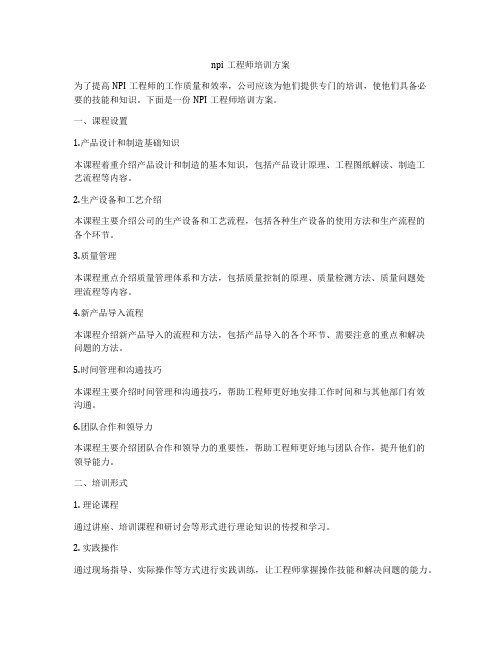
npi工程师培训方案为了提高NPI工程师的工作质量和效率,公司应该为他们提供专门的培训,使他们具备必要的技能和知识。
下面是一份NPI工程师培训方案。
一、课程设置1.产品设计和制造基础知识本课程着重介绍产品设计和制造的基本知识,包括产品设计原理、工程图纸解读、制造工艺流程等内容。
2.生产设备和工艺介绍本课程主要介绍公司的生产设备和工艺流程,包括各种生产设备的使用方法和生产流程的各个环节。
3.质量管理本课程重点介绍质量管理体系和方法,包括质量控制的原理、质量检测方法、质量问题处理流程等内容。
4.新产品导入流程本课程介绍新产品导入的流程和方法,包括产品导入的各个环节、需要注意的重点和解决问题的方法。
5.时间管理和沟通技巧本课程主要介绍时间管理和沟通技巧,帮助工程师更好地安排工作时间和与其他部门有效沟通。
6.团队合作和领导力本课程主要介绍团队合作和领导力的重要性,帮助工程师更好地与团队合作,提升他们的领导能力。
二、培训形式1. 理论课程通过讲座、培训课程和研讨会等形式进行理论知识的传授和学习。
2. 实践操作通过现场指导、实际操作等方式进行实践训练,让工程师掌握操作技能和解决问题的能力。
3.案例分析通过分析公司实际的新产品导入案例,让工程师学会从实际案例中总结经验和教训。
4.考核评估培训结束后,通过考核和评估,评定工程师的学习成果,为他们提供进一步的指导和改进方案。
三、培训计划1.培训时间整个培训计划为期三个月,分为理论课程和实践操作两个阶段进行。
2.培训场所培训课程可以在公司内部的培训室进行,实践操作可以在生产车间、实验室等现场进行。
3.培训导师培训导师可以由公司内部专业人员或外部专家教授,确保培训质量和有效性。
四、培训效果评估1.通过考核评估,评定工程师的学习成果和综合能力水平,为进一步改进和提高员工的工作水平提供数据参考。
2.定期跟踪调研,收集员工对培训和工作的反馈意见,及时调整培训方案和措施,确保培训效果。
2024版PIE工程师培训教程

PIE工程师培训教程•引言•PIE工程师基础知识•PIE工程师技能提升•PIE工程师实践操作目录•PIE工程师职业素养培养•PIE工程师培训总结和展望引言01培训目的和意义目的培养具备PIE专业技能和知识的工程师,提高生产效率,优化生产流程,降低生产成本。
意义通过培训,使学员掌握PIE工程的核心技术和方法,能够独立解决生产过程中的问题,提升企业竞争力。
培训对象和要求对象面向制造业相关从业人员,包括生产工程师、工艺工程师、设备工程师等。
要求学员需具备一定的机械、电子、自动化等基础知识,对生产流程和工艺有一定了解。
培训内容和方式内容涵盖PIE工程的基本概念、原理、技术和方法,包括生产流程优化、工艺改进、设备维护与管理等方面的知识。
方式采用理论授课、案例分析、实践操作相结合的方式,注重学员的实际操作能力和问题解决能力的培养。
PIE工程师基础知识02010204 PIE工程师职责和角色负责生产工艺流程的制定和优化,提高生产效率,降低生产成本。
负责生产设备的选型和调试,确保设备满足生产需求。
负责新产品的导入和试产,协助解决生产过程中的技术难题。
负责生产现场的技术支持和问题解决,提高生产线的稳定性和产品质量。
03工艺流程和设备介绍工艺流程包括原材料准备、加工、装配、测试和包装等环节,确保产品按照规定的工艺流程进行生产。
设备介绍包括生产设备、测试设备和辅助设备等,如数控机床、注塑机、贴片机、光谱仪等,确保设备能够满足生产需求并提高生产效率。
产品知识和质量要求产品知识了解产品的结构、功能、性能和使用方法等,以便更好地进行生产工艺的制定和优化。
质量要求熟悉产品质量标准和检验方法,确保产品符合质量要求,提高客户满意度。
同时,需要了解相关质量管理体系,如ISO9001等,以便更好地进行质量管理。
PIE工程师技能提升03工艺流程分析工艺参数调整新工艺研发跨工艺领域协作工艺优化和改进方法01020304对现有工艺流程进行全面分析,找出瓶颈和浪费环节,提出优化建议。
AMG5000产品介绍与硬件结构工程师培训胶片ISSUE1.0-20050223-A

20
华为机密, 华为机密,未经许可不得扩散 文档密级: 文档密级:内部公开
AMG5000产品之间关系 产品之间关系
AMG5160不支持主备,不支持级联 AMG5320支持主备,支持级联 综合AG:AMG5000支持主备,支持级联,,未经许可不得扩散 文档密级: 文档密级:内部公开
•AMG5320采用 采用F01机柜,电源及监控部件、蓄电池、用户板和测试板 机柜, 采用 机柜 电源及监控部件、蓄电池、 可以继承原产品。 可以继承原产品。 •AMG5320共18个槽位(槽位号从左至右 ~17), 共 个槽位 槽位号从左至右0~ ), 个槽位( ),9/10槽位固定为主 槽位固定为主 块用户板, 用户板, 控PVM板,最多 块用户板,可以兼容 或32路ASL用户板, 板 最多10块用户板 可以兼容16或 路 用户板 10*32=320端口。 端口。 端口
学习目标
学习完本课程,您应该能够: 学习完本课程,您应该能够:
掌握AMG5000的功能特点、系统结构 掌握 的功能特点、 的功能特点 掌握AMG5000的硬件和组网应用 的硬件和组网应用 掌握
4
华为机密, 华为机密,未经许可不得扩散 文档密级: 文档密级:内部公开
课程内容
第一章 AMG5000概述 概述 第二章 AMG5000系统结构 系统结构 第三章 AMG5000组网应用 组网应用
AMG5000逻辑结构 逻辑结构
TDM控制和 交换模块 HW总线 高速总线
分组语 音处理 模块
分组控制和 交换模块
FE/GE
POTS ISDN
ADSL ADSL2+ VDSL ATM SHDSL
网络接口模块
业务接口模块
22
华为机密, 华为机密,未经许可不得扩散 文档密级: 文档密级:内部公开
硬件系统介绍工程师培训胶片ISSUE

SoftX3000 单板列表
单板名称
英文全称
SMUI SIUI IFMI BFII HSCI FCCU CDBI BSGI MSGI MRCA MRIA ALUI UPWR
System Management Unit System Interface Unit IP Forward Module Back insert FE Interface Unit Hot-Swap and Control Unit Fixed Calling Control Unit Central Database Board Broadband Signaling Gateway Multimedia Signaling Gateway Unit Media Resource Control Unit Media Resource Interface Unit Alarm Unit Universal Power
¦ 维护管理子系统(又称为“后台” ):主要完成操作维护、话单 管理等功能 [ BAM(后管理模块)、WS(工作站):操作维护 [ iGWB:话单管理
¦ 环境监控子系统 [ 电源模块监控、风扇监控模块和每个机柜的配电框监控模块
硬件系统介绍工程师培训胶片ISSUE
SoftX3000的物理结构图
硬件系统介绍工程师培训胶片ISSUE
基本框 (9U)
扩展 框 (9U)
扩展 框 (9U)
扩展 框 (9U)
KVM(1U)
导风框 (2U)
KVMS(1U) 1# LAN Switch(1U)
走线槽 (1U) 0# LAN Switch(1U)
走线槽 (1U) 磁盘阵列 (3U)
BAM(2U)
PIE工程师培训技能课件

THANKS
感谢观看
数据处理
运用统计学、机器学习等方法对 采集到的数据进行清洗、筛选、 转换等处理,以提取有用信息。
可视化展示
利用数据可视化工具,如 Tableau、Power BI等,将处理 后的数据以图表、仪表盘等形式 展示出来,便于分析和决策。
基于数据驱动的持续改进策略
1 2 3
数据驱动决策
通过对历史数据和实时数据的分析,发现生产过 程中的瓶颈和问题,为决策提供支持。
PIE工程师培训技能 课件
目录
• PIE工程师概述 • 工艺流程设计与优化 • 设备选型、维护与故障排除 • 生产过程监控与数据分析 • 质量控制与改进方法 • 团队协作与沟通能力提升
01
PIE工程师概述
PIE工程师职责与素质要求
职责
负责生产工艺的制定、改进与维护,确保生产过程的顺利进行;负责生产设备 的管理与优化,提高生产效率和产品质量;协调相关部门解决生产过程中的技 术难题,提供技术支持。
持续改进
运用PDCA循环、六西格玛等管理方法和工具, 对生产过程进行持续改进,提高产品质量和生产 效率。
智能化升级
引入先进的人工智能、机器学习等技术,实现生 产过程的智能化升级,提高生产线的自动化程度 和智能化水平。
05
质量控制与改进方法
质量管理体系建立及运行维护
质量管理体系的构成
包括质量方针、目标、组织结构、职责、程序、资源和持续改进 等要素。
持续改进方法在质量提升 中的应用步骤
明确改进目标、识别问题、分析原因、制定 改进措施、实施改进并验证效果。在此过程 中,需要注重数据的收集和分析,以客观评 估改进效果并推动持续改进。同时,还需要 关注员工参与和培训,激发员工的改进意识
PIE工程师培训教材(2024)
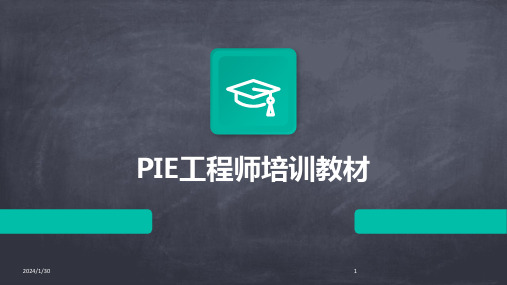
对未来发展趋势的预测和建议
2024/1/30
先进制造工艺的持续创新
随着半导体技术的不断发展,未来制造工艺将更加精细和复杂,PIE工程师需要不断学习 和掌握新的工艺技术。
智能制造与自动化趋势
智能制造和自动化将成为半导体制造领域的重要发展方向,PIE工程师需要关注并适应这 一趋势,提高生产效率和降低成本。
2024/1/30
故障诊断方法
01
掌握设备故障的诊断方法,如观察、听诊、检测等。
常见故障类型及处理
02
熟悉设备常见的故障类型、原因及相应的处理方法。
预防措施与应急预案
03
了解设备故障的预防措施及应急预案的制定和实施。
15
03
生产工艺优化与改进
Chapter
2024/1/30
16
生产线布局规划及优化方法
PIE工程师培训教材
2024/1/30
1
目录
2024/1/30
• PIE工程师概述 • 工艺流程与设备基础 • 生产工艺优化与改进 • 产品品质管理与控制 • 自动化技术应用与智能制造发展趋势 • 项目管理能力提升 • 总结回顾与展望未来
2
01
PIE工程师概述
Chapter
2024/1/30
3
PIE工程师职责与技能要求
2024/1/30
25
自动化生产线设计原则及实施步骤
2024/1/30
可靠性
确保设备稳定运行,减少故障率 。
安全性
保障员工和设备安全,符合相关 法规和标准。
26
自动化生产线设计原则及实施步骤
需求分析
明确生产需求和目标,制定设计方案 。 Nhomakorabea设备选型
装配车间安全意识培训教材31

【推荐】装配车间安全意识培训教材3 1
对待设备错误多观念
昨天清洁过,今天还是干净的,明天再清 洁一样的。
保养刷油干嘛,我急着下班回家有事,就 一天不刷油又不会生锈。
检修就是浪费时间和成本,机器又还没有 坏。
【推荐】装配车间安全意识培训教材3 1
【推荐】装配车间安全意识培训教材3 1
谈谈好处
2.混凝土浇筑前,项目总工程师要组 织有关 人员进 行技术 交底, 明确混 凝土浇 筑工艺 、特点 、施工 注意事 项等, 项目付 经理要 组织施 工机具 、商品 混凝土 供应及 运输、 劳动力 布置, 技术、 质检部 门作好 质量控 制计划 。
3.派出专人到拌合站负责拌合质量的 监察和 供应、 运输联 络。
【推荐】装配车间安全意识培训教材3 1 【推荐】装配车间安全意识培训教材3 1
【推荐】装配车间安全意识培训教材3 1 【推荐】装配车间安全意识培训教材3 1
【推荐】装配车间安全意识培训教材3 1
气动压力机
【推荐】装配车间安全意识培训教材3 1
I级晋升培训教材
12
【推荐】装配车间安全意识培训教材3 1 【推荐】装配车间安全意识培训教材3 1
3、手代替工具操作:用手代替手动工具, 用手清除切屑,不用夹具固定、用手 拿工件进行机加工, 物品存放不当。
【推荐】装配车间安全意识培训教材3 1
【推荐】装配车间安全意识培训教材3 1
人的不安全行为:
4未穿戴劳保用品:在必须使用个人防护用品
用具的作业场所忽视其作用。
5不安全装束:在有旋转零件的设备旁作业穿
【推荐】装配车间安全意识培训教材3 1 【推荐】装配车间安全意识培训教材3 1
【推荐】装配车间安全意识培训教材3 1 【推荐】装配车间安全意识培训教材3 1
________________________________________________ Session S3C MINORITY ENGINEERING PROGRAM C
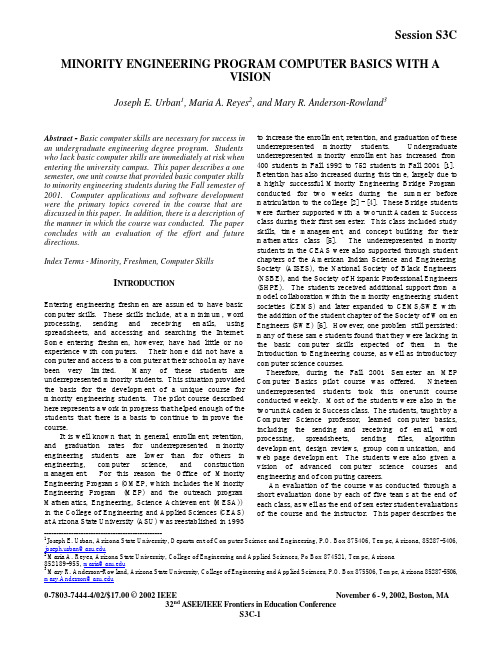
________________________________________________ 1Joseph E. Urban, Arizona State University, Department of Computer Science and Engineering, P.O. Box 875406, Tempe, Arizona, 85287-5406, joseph.urban@ 2Maria A. Reyes, Arizona State University, College of Engineering and Applied Sciences, Po Box 874521, Tempe, Arizona 852189-955, maria@ 3Mary R. Anderson-Rowland, Arizona State University, College of Engineering and Applied Sciences, P.O. Box 875506, Tempe, Arizona 85287-5506, mary.Anderson@MINORITY ENGINEERING PROGRAM COMPUTER BASICS WITH AVISIONJoseph E. Urban 1, Maria A. Reyes 2, and Mary R. Anderson-Rowland 3Abstract - Basic computer skills are necessary for success in an undergraduate engineering degree program. Students who lack basic computer skills are immediately at risk when entering the university campus. This paper describes a one semester, one unit course that provided basic computer skills to minority engineering students during the Fall semester of 2001. Computer applications and software development were the primary topics covered in the course that are discussed in this paper. In addition, there is a description of the manner in which the course was conducted. The paper concludes with an evaluation of the effort and future directions.Index Terms - Minority, Freshmen, Computer SkillsI NTRODUCTIONEntering engineering freshmen are assumed to have basic computer skills. These skills include, at a minimum, word processing, sending and receiving emails, using spreadsheets, and accessing and searching the Internet. Some entering freshmen, however, have had little or no experience with computers. Their home did not have a computer and access to a computer at their school may have been very limited. Many of these students are underrepresented minority students. This situation provided the basis for the development of a unique course for minority engineering students. The pilot course described here represents a work in progress that helped enough of the students that there is a basis to continue to improve the course.It is well known that, in general, enrollment, retention, and graduation rates for underrepresented minority engineering students are lower than for others in engineering, computer science, and construction management. For this reason the Office of Minority Engineering Programs (OMEP, which includes the Minority Engineering Program (MEP) and the outreach program Mathematics, Engineering, Science Achievement (MESA)) in the College of Engineering and Applied Sciences (CEAS) at Arizona State University (ASU) was reestablished in 1993to increase the enrollment, retention, and graduation of these underrepresented minority students. Undergraduate underrepresented minority enrollment has increased from 400 students in Fall 1992 to 752 students in Fall 2001 [1]. Retention has also increased during this time, largely due to a highly successful Minority Engineering Bridge Program conducted for two weeks during the summer before matriculation to the college [2] - [4]. These Bridge students were further supported with a two-unit Academic Success class during their first semester. This class included study skills, time management, and concept building for their mathematics class [5]. The underrepresented minority students in the CEAS were also supported through student chapters of the American Indian Science and Engineering Society (AISES), the National Society of Black Engineers (NSBE), and the Society of Hispanic Professional Engineers (SHPE). The students received additional support from a model collaboration within the minority engineering student societies (CEMS) and later expanded to CEMS/SWE with the addition of the student chapter of the Society of Women Engineers (SWE) [6]. However, one problem still persisted: many of these same students found that they were lacking in the basic computer skills expected of them in the Introduction to Engineering course, as well as introductory computer science courses.Therefore, during the Fall 2001 Semester an MEP Computer Basics pilot course was offered. Nineteen underrepresented students took this one-unit course conducted weekly. Most of the students were also in the two-unit Academic Success class. The students, taught by a Computer Science professor, learned computer basics, including the sending and receiving of email, word processing, spreadsheets, sending files, algorithm development, design reviews, group communication, and web page development. The students were also given a vision of advanced computer science courses and engineering and of computing careers.An evaluation of the course was conducted through a short evaluation done by each of five teams at the end of each class, as well as the end of semester student evaluations of the course and the instructor. This paper describes theclass, the students, the course activities, and an assessment of the short-term overall success of the effort.M INORITY E NGINEERING P ROGRAMSThe OMEP works actively to recruit, to retain, and to graduate historically underrepresented students in the college. This is done through targeted programs in the K-12 system and at the university level [7], [8]. The retention aspects of the program are delivered through the Minority Engineering Program (MEP), which has a dedicated program coordinator. Although the focus of the retention initiatives is centered on the disciplines in engineering, the MEP works with retention initiatives and programs campus wide.The student’s efforts to work across disciplines and collaborate with other culturally based organizations give them the opportunity to work with their peers. At ASU the result was the creation of culturally based coalitions. Some of these coalitions include the American Indian Council, El Concilio – a coalition of Hispanic student organizations, and the Black & African Coalition. The students’ efforts are significant because they are mirrored at the program/staff level. As a result, significant collaboration of programs that serve minority students occurs bringing continuity to the students.It is through a collaboration effort that the MEP works closely with other campus programs that serve minority students such as: Math/Science Honors Program, Hispanic Mother/Daughter Program, Native American Achievement Program, Phoenix Union High School District Partnership Program, and the American Indian Institute. In particular, the MEP office had a focus on the retention and success of the Native American students in the College. This was due in large part to the outreach efforts of the OMEP, which are channeled through the MESA Program. The ASU MESA Program works very closely with constituents on the Navajo Nation and the San Carlos Apache Indian Reservation. It was through the MESA Program and working with the other campus support programs that the CEAS began investigating the success of the Native American students in the College. It was a discovery process that was not very positive. Through a cohort investigation that was initiated by the Associate Dean of Student Affairs, it was found that the retention rate of the Native American students in the CEAS was significantly lower than the rate of other minority populations within the College.In the spring of 2000, the OMEP and the CEAS Associate Dean of Student Affairs called a meeting with other Native American support programs from across the campus. In attendance were representatives from the American Indian Institute, the Native American Achievement Program, the Math/Science Honors Program, the Assistant Dean of Student Life, who works with the student coalitions, and the Counselor to the ASU President on American Indian Affairs, Peterson Zah. It was throughthis dialogue that many issues surrounding student success and retention were discussed. Although the issues andconcerns of each participant were very serious, the positiveeffect of the collaboration should be mentioned and noted. One of the many issues discussed was a general reality that ahigh number of Native American students were c oming to the university with minimal exposure to technology. Even through the efforts in the MESA program to expose studentsto technology and related careers, in most cases the schoolsin their local areas either lacked connectivity or basic hardware. In other cases, where students had availability to technology, they lacked teachers with the skills to help them in their endeavors to learn about it. Some students were entering the university with the intention to purse degrees in the Science, Technology, Engineering, and Mathematics (STEM) areas, but were ill prepared in the skills to utilize technology as a tool. This was particularly disturbing in the areas of Computer Science and Computer Systems Engineering where the basic entry-level course expected students to have a general knowledge of computers and applications. The result was evident in the cohort study. Students were failing the entry-level courses of CSE 100 (Principals of Programming with C++) or CSE 110 (Principals of Programming with Java) and CSE 200 (Concepts of Computer Science) that has the equivalent of CSE 100 or CSE 110 as a prerequisite. The students were also reporting difficulty with ECE 100, (Introduction to Engineering Design) due to a lack of assumed computer skills. During the discussion, it became evident that assistance in the area of technology skill development would be of significance to some students in CEAS.The MEP had been offering a seminar course inAcademic Success – ASE 194. This two-credit coursecovered topics in study skills, personal development, academic culture issues and professional development. The course was targeted to historically underrepresented minority students who were in the CEAS [3]. It was proposed by the MEP and the Associate Dean of Student Affairs to add a one-credit option to the ASE 194 course that would focus entirely on preparing students in the use of technology.A C OMPUTERB ASICSC OURSEThe course, ASE 194 – MEP Computer Basics, was offered during the Fall 2001 semester as a one-unit class that met on Friday afternoons from 3:40 pm to 4:30 pm. The course was originally intended for entering computer science students who had little or no background using computer applications or developing computer programs. However, enrollment was open to non-computer science students who subsequently took advantage of the opportunity. The course was offered in a computer-mediated classroom, which meantthat lectures, in- class activities, and examinations could all be administered on comp uters.During course development prior to the start of the semester, the faculty member did some analysis of existing courses at other universities that are used by students to assimilate computing technology. In addition, he did a review of the comp uter applications that were expected of the students in the courses found in most freshman engineering programs.The weekly class meetings consisted of lectures, group quizzes, accessing computer applications, and group activities. The lectures covered hardware, software, and system topics with an emphasis on software development [9]. The primary goals of the course were twofold. Firstly, the students needed to achieve a familiarity with using the computer applications that would be expected in the freshman engineering courses. Secondly, the students were to get a vision of the type of activities that would be expected during the upper division courses in computer science and computer systems engineering and later in the computer industry.Initially, there were twenty-two students in the course, which consisted of sixteen freshmen, five sophomores, and one junior. One student, a nursing freshman, withdrew early on and never attended the course. Of the remaining twenty-one students, there were seven students who had no degree program preference; of which six students now are declared in engineering degree programs and the seventh student remains undecided. The degree programs of the twenty-one students after completion of the course are ten in the computing degree programs with four in computer science and six in computer systems engineering. The remaining nine students includes one student in social work, one student is not decided, and the rest are widely distributed over the College with two students in the civil engineering program and one student each in bioengineering, electrical engineering, industrial engineering, material science & engineering, and mechanical engineering.These student degree program demographics presented a challenge to maintain interest for the non-computing degree program students when covering the software development topics. Conversely, the computer science and computer systems engineering students needed motivation when covering applications. This balance was maintained for the most part by developing an understanding that each could help the other in the long run by working together.The computer applications covered during the semester included e-mail, word processing, web searching, and spreadsheets. The original plan included the use of databases, but that was not possible due to the time limitation of one hour per week. The software development aspects included discussion of software requirements through specification, design, coding, and testing. The emphasis was on algorithm development and design review. The course grade was composed of twenty-five percent each for homework, class participation, midterm examination, and final examination. An example of a homework assignment involved searching the web in a manner that was more complex than a simple search. In order to submit the assignment, each student just had to send an email message to the faculty member with the information requested below. The email message must be sent from a student email address so that a reply can be sent by email. Included in the body of the email message was to be an answer for each item below and the URLs that were used for determining each answer: expected high temperature in Centigrade on September 6, 2001 for Lafayette, LA; conversion of one US Dollar to Peruvian Nuevo Sols and then those converted Peruvian Nuevo Sols to Polish Zlotys and then those converted Polish Zlotys to US Dollars; birth date and birth place of the current US Secretary of State; between now and Thursday, September 6, 2001 at 5:00 pm the expected and actual arrival times for any US domestic flight that is not departing or arriving to Phoenix, AZ; and your favorite web site and why the web site is your favorite. With the exception of the favorite web site, each item required either multiple sites or multiple levels to search. The identification of the favorite web site was introduced for comparison purposes later in the semester.The midterm and final examinations were composed of problems that built on the in-class and homework activities. Both examinations required the use of computers in the classroom. The submission of a completed examination was much like the homework assignments as an e-mail message with attachments. This approach of electronic submission worked well for reinforcing the use of computers for course deliverables, date / time stamping of completed activities, and a means for delivering graded results. The current technology leaves much to be desired for marking up a document in the traditional sense of hand grading an assignment or examination. However, the students and faculty member worked well with this form of response. More importantly, a major problem occurred after the completion of the final examination. One of the students, through an accident, submitted the executable part of a browser as an attachment, which brought the e-mail system to such a degraded state that grading was impossible until the problem was corrected. An ftp drop box would be simple solution in order to avoid this type of accident in the future until another solution is found for the e-mail system.In order to get students to work together on various aspects of the course, there was a group quiz and assignment component that was added about midway through the course. The group activities did not count towards the final grade, however the students were promised an award for the group that scored the highest number of points.There were two group quizzes on algorithm development and one out-of-class group assignment. The assignment was a group effort in website development. This assignment involved the development of a website that instructs. The conceptual functionality the group selected for theassignment was to be described in a one-page typed double spaced written report by November 9, 2001. During the November 30, 2001 class, each group presented to the rest of the class a prototype of what the website would look like to the end user. The reports and prototypes were subject to approval and/or refinement. Group members were expected to perform at approximately an equal amount of effort. There were five groups with four members in four groups and three members in one group that were randomly determined in class. Each group had one or more students in the computer science or computer systems engineering degree programs.The three group activities were graded on a basis of one million points. This amount of points was interesting from the standpoint of understanding relative value. There was one group elated over earning 600,000 points on the first quiz until the group found out that was the lowest score. In searching for the group award, the faculty member sought a computer circuit board in order to retrieve chips for each member of the best group. During the search, a staff member pointed out another staff member who salvages computers for the College. This second staff member obtained defective parts for each student in the class. The result was that each m ember of the highest scoring group received a motherboard, in other words, most of the internals that form a complete PC. All the other students received central processing units. Although these “awards” were defective parts, the students viewed these items as display artifacts that could be kept throughout their careers.C OURSE E VALUATIONOn a weekly basis, there were small assessments that were made about the progress of the course. One student was selected from each team to answer three questions about the activities of the day: “What was the most important topic covered today?”, “What topic covered was the ‘muddiest’?”, and “About what topic would you like to know more?”, as well as the opportunity to provide “Other comments.” Typically, the muddiest topic was the one introduced at the end of a class period and to be later elaborated on in the next class. By collecting these evaluation each class period, the instructor was able to keep a pulse on the class, to answer questions, to elaborate on areas considered “muddy” by the students, and to discuss, as time allowed, topics about which the students wished to know more.The overall course evaluation was quite good. Nineteen of the 21 students completed a course evaluation. A five-point scale w as used to evaluate aspects of the course and the instructor. An A was “very good,” a B was “good,” a C was “fair,” a D was “poor,” and an E was “not applicable.” The mean ranking was 4.35 on the course. An average ranking of 4.57, the highest for the s even criteria on the course in general, was for “Testbook/ supplementary material in support of the course.” The “Definition and application of criteria for grading” received the next highest marks in the course category with an average of 4.44. The lowest evaluation of the seven criteria for the course was a 4.17 for “Value of assigned homework in support of the course topics.”The mean student ranking of the instructor was 4.47. Of the nine criteria for the instructor, the highest ranking of 4.89 was “The instructor exhibited enthusiasm for and interest in the subject.” Given the nature and purpose of this course, this is a very meaningful measure of the success of the course. “The instructor was well prepared” was also judged high with a mean rank of 4.67. Two other important aspects of this course, “The instructor’s approach stimulated student thinking” and “The instructor related course material to its application” were ranked at 4.56 and 4.50, respectively. The lowest average rank of 4.11 was for “The instructor or assistants were available for outside assistance.” The instructor keep posted office hours, but there was not an assistant for the course.The “Overall quality of the course and instruction” received an average rank of 4.39 and “How do you rate yourself as a student in this course?” received an average rank of 4.35. Only a few of the students responded to the number of hours per week that they studies for the course. All of the students reported attending at least 70% of the time and 75% of the students said that they attended over 90% of the time. The students’ estimate seemed to be accurate.A common comment from the student evaluations was that “the professor was a fun teacher, made class fun, and explained everything well.” A common complaint was that the class was taught late (3:40 to 4:30) on a Friday. Some students judged the class to be an easy class that taught some basics about computers; other students did not think that there was enough time to cover all o f the topics. These opposite reactions make sense when we recall that the students were a broad mix of degree programs and of basic computer abilities. Similarly, some students liked that the class projects “were not overwhelming,” while other students thought that there was too little time to learn too much and too much work was required for a one credit class. Several students expressed that they wished the course could have been longer because they wanted to learn more about the general topics in the course. The instructor was judged to be a good role model by the students. This matched the pleasure that the instructor had with this class. He thoroughly enjoyed working with the students.A SSESSMENTS A ND C ONCLUSIONSNear the end of the Spring 2002 semester, a follow-up survey that consisted of three questions was sent to the students from the Fall 2001 semester computer basics course. These questions were: “Which CSE course(s) wereyou enrolled in this semester?; How did ASE 194 - Computer Basi cs help you in your coursework this semester?; and What else should be covered that we did not cover in the course?”. There were eight students who responded to the follow-up survey. Only one of these eight students had enrolled in a CSE course. There was consistency that the computer basics course helped in terms of being able to use computer applications in courses, as well as understanding concepts of computing. Many of the students asked for shortcuts in using the word processing and spreadsheet applications. A more detailed analysis of the survey results will be used for enhancements to the next offering of the computer basics course. During the Spring 2002 semester, there was another set of eight students from the Fall 2001 semester computer basi cs course who enrolled in one on the next possible computer science courses mentioned earlier, CSE 110 or CSE 200. The grade distribution among these students was one grade of A, four grades of B, two withdrawals, and one grade of D. The two withdrawals appear to be consistent with concerns in the other courses. The one grade of D was unique in that the student was enrolled in a CSE course concurrently with the computer basics course, contrary to the advice of the MEP program. Those students who were not enrolled in a computer science course during the Spring 2002 semester will be tracked through the future semesters. The results of the follow-up survey and computer science course grade analysis will provide a foundation for enhancements to the computer basics course that is planned to be offered again during the Fall 2002 semester.S UMMARY A ND F UTURE D IRECTIONSThis paper described a computer basics course. In general, the course was considered to be a success. The true evaluation of this course will be measured as we do follow-up studies of these students to determine how they fare in subsequent courses that require basic computer skills. Future offerings of the course are expected to address non-standard computing devices, such as robots as a means to inspire the students to excel in the computing field.R EFERENCES[1] Office of Institutional Analysis, Arizona State UniversityEnro llment Summary, Fall Semester , 1992-2001, Tempe,Arizona.[2] Reyes, Maria A., Gotes, Maria Amparo, McNeill, Barry,Anderson-Rowland, Mary R., “MEP Summer Bridge Program: A Model Curriculum Project,” 1999 Proceedings, American Society for Engineering Education, Charlotte, North Carolina, June 1999, CD-ROM, 8 pages.[3] Reyes, Maria A., Anderson-Rowland, Mary R., andMcCartney, Mary Ann, “Learning from our MinorityEngineering Students: Improving Retention,” 2000Proceedings, American Society for Engineering Education,St. Louis, Missouri, June 2000, Session 2470, CD-ROM, 10pages.[4] Adair, Jennifer K,, Reyes, Maria A., Anderson-Rowland,Mary R., McNeill, Barry W., “An Education/BusinessPartnership: ASU’s Minority Engineering Program and theTempe Chamber of Commerce,” 2001 Proceeding, AmericanSociety for Engineering Education, Albuquerque, NewMexico, June 2001, CD-ROM, 9 pages.[5] Adair, Jennifer K., Reyes, Maria A., Anderson-Rowland,Mary R., Kouris, Demitris A., “Workshops vs. Tutoring:How ASU’s Minority Engineering Program is Changing theWay Engineering Students Learn, “ Frontiers in Education’01 Conference Proceedings, Reno, Nevada, October 2001,CD-ROM, pp. T4G-7 – T4G-11.[6] Reyes, Maria A., Anderson-Rowland, Mary R., Fletcher,Shawna L., and McCartney, Mary Ann, “ModelCollaboration within Minority Engineering StudentSocieties,” 2000 Proceedings, American Society forEngineering Education, St. Louis, Missouri, June 2000, CD-ROM, 8 pages.[7] Anderson-Rowland, Mary R., Blaisdell, Stephanie L.,Fletcher, Shawna, Fussell, Peggy A., Jordan, Cathryne,McCartney, Mary Ann, Reyes, Maria A., and White, Mary,“A Comprehensive Programmatic Approach to Recruitmentand Retention in the College of Engineering and AppliedSciences,” Frontiers in Education ’99 ConferenceProceedings, San Juan, Puerto Rico, November 1999, CD-ROM, pp. 12a7-6 – 12a7-13.[8] Anderson-Rowland, Mary R., Blaisdell, Stephanie L.,Fletcher, Shawna L., Fussell, Peggy A., McCartney, MaryAnn, Reyes, Maria A., and White, Mary Aleta, “ACollaborative Effort to Recruit and Retain UnderrepresentedEngineering Students,” Journal of Women and Minorities inScience and Engineering, vol.5, pp. 323-349, 1999.[9] Pfleeger, S. L., Software Engineering: Theory and Practice,Prentice-Hall, Inc., Upper Saddle River, NJ, 1998.。
NPI工程师培训资料_2022年学习资料

新產品導入流程-DRI-Item-Action item-unit-Remark-Check points 3-工程可行性評估-NPI-密切聯系制造和制工-1.特别是新技求,新制程的可行性-評估,研究和准備工作-K ep the contact-1.The evaluation and-Engineering feasi ility-close with manufa--preparation of new technolog -cture and manufac--and process-ture engineer-工程資料獲得与 轉相關部門-工程資料括:BOM,Overlay,Board-file,Schematic,MPS,Cosm tic-l.所有资料可以由Compass或MCMs網-站下载或由客户的Email得到-4-Inspecti n Criterion,Stencil-量試說明會發布-Job Number,Fixture shippi g-2.确認所有资料是否到位或有更新-tracking Number,Test Program-3.若有更 告知相关部门-release date.-Engineering documents acquire,-i cluding BOM,Overlay,Board-1.Download all files from-C mpass/MCMS or by email-Build preparation-2.To verify f all files are-meeting-completed or updated-tracking Number,Test Program,-3.Forward to all department if-a d forward to related-any update
MRS结构原理及数据配置工程师培训胶片

接口实现及功能
SoftX
MGCP
NGN
GE/FE
MRS6000
TMG
信令通路 媒体流通路
➢协议 •MGCP,SIP
➢接口 •FE/GE
➢基本功能: •支持放音、收号、会议资源 •语音编解码:G.711、G.723、G.729
➢增强功能 •语音识别ASR/文语转换TTS •Voice/Video Conference •Multimedia Record & Playback
MRS 6100-数据配置-增加语音
添加语音文件-ADD MSUV :
1、执行一次ADD MSUV可增加单条语音;
2、使用批处理命令批加载语音:
执行方法是按下快捷键“Ctrl+E”,或者从菜单中的“System”子菜单中 选择“Execute Batch Command”。在弹出的对话框中点击“Brower…” ,选择将一组ADD MSUV命令编辑为文本的执行后批加载语音的文 本文件,点击OK。此时文件中所有的命令都会显示出来,点击脚 本执行框中的“Go”就可以批处理执行脚本
搜集和对DTMF信号进行解码; 为测试和支持各种PSTN的应用设备而生成DTMF信号; 保存和回放预先已经录制好的静态语音片,如公告; 录制和回放各种临时的语音片; 为多方会议提供各种音频信号的桥接和可选的增益控制功能; 在一个会议中对音频信号进行侦别,使得发言声音最高的用户成
为当前的发言方; 在多方会议、公告和对语音片的回放操作中,可以在不同的编解
小结
位于NGN典型组网的业务层 MRS是提供媒体资源的服务器 MRS使用MGCP协议和Softswitch互通 提供放音、收号等功能
小结(三者区别)
MRS6000
2024版PIE工程师技能提升培训教材

03
PIE工程师技能提升
2024/1/29
11
问题分析和解决能力
掌握问题分析和解决的基本流程和方 法,如5W1H、鱼骨图等。
熟练掌握常用的数据分析工具和技术, 如Excel、SQL等,能够通过数据分 析找到问题的症结所在。
2024/1/29
具备对复杂问题进行深入剖析和拆解 的能力,能够识别问题的根本原因。
17
品质检测和控制技能
品质检测
掌握各种品质检测方法和工具, 能够对产品进行全面的品质检测
和评估。
2024/1/29
品质控制
制定品质控制标准和流程,对生产 过程中的品质问题进行跟踪和处理, 确保产品品质符合要求。
品质改进
通过对品质数据的分析和处理,提 出品质改进方案和建议,推动产品 品质的持续提升。
2024/1/29
23
20
学员反馈和建议收集
学员对培训内容和方式表示满 意,认为培训内容与工作实际 紧密结合,有助于提高工作能 力和水平。
2024/1/29
部分学员建议增加一些前沿技 术和新兴应用领域的内容,以 适应行业快速发展的需求。
学员希望加强培训后的跟踪和 辅导,以便更好地将所学应用 于实际工作中。
21
未来发展趋势和展望
01
02
03
04
熟练掌握品质控制方法和工具, 如SPC、FMEA、MSA等
了解品质管理体系和相关标准, 如ISO9001、TS16949等
熟悉产品品质不良的处理流程 和改善措施,包括原因分析、
纠正措施制定和实施等
具备较强的问题分析和解决能 力,能够及时处理产品品质问
题并推动改善
2024/1/29
10
2024年PIE工程师培训教程
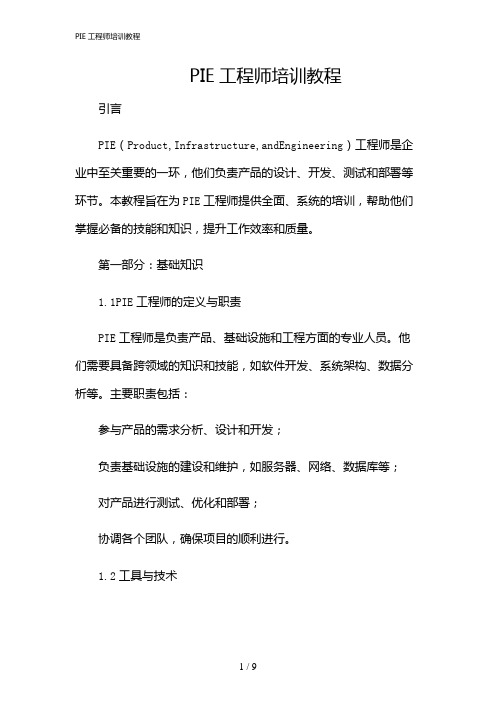
PIE工程师培训教程引言PIE(Product,Infrastructure,andEngineering)工程师是企业中至关重要的一环,他们负责产品的设计、开发、测试和部署等环节。
本教程旨在为PIE工程师提供全面、系统的培训,帮助他们掌握必备的技能和知识,提升工作效率和质量。
第一部分:基础知识1.1PIE工程师的定义与职责PIE工程师是负责产品、基础设施和工程方面的专业人员。
他们需要具备跨领域的知识和技能,如软件开发、系统架构、数据分析等。
主要职责包括:参与产品的需求分析、设计和开发;负责基础设施的建设和维护,如服务器、网络、数据库等;对产品进行测试、优化和部署;协调各个团队,确保项目的顺利进行。
1.2工具与技术PIE工程师需要熟练掌握各种工具和技术,以提高工作效率。
常见的工具和技术包括:版本控制系统(如Git、SVN);项目管理工具(如Jira、Trello);自动化构建和部署工具(如Jenkins、Docker);编程语言(如Java、、Go);数据库技术(如MySQL、MongoDB);云计算平台(如AWS、Azure、阿里云)。
第二部分:核心技能2.1需求分析与管理与产品经理、设计师等团队成员沟通,明确产品需求;编写需求文档,确保需求清晰、可执行;跟踪需求变更,及时调整项目计划。
2.2系统架构与设计根据产品需求,设计合理的系统架构;选择合适的开发框架和技术栈;进行技术选型,确保系统的性能、可扩展性和安全性。
2.3编码与开发熟练掌握至少一种编程语言;遵循编码规范,编写高质量、可维护的代码;进行单元测试,确保代码的正确性。
2.4测试与优化编写测试用例,进行功能测试、性能测试等;分析测试结果,定位问题并解决;对系统进行优化,提高性能和稳定性。
2.5部署与运维熟练使用自动化构建和部署工具;负责服务器、网络、数据库等基础设施的运维;监控系统运行状态,确保系统稳定运行。
第三部分:实践与案例分析本部分将通过实际案例,介绍PIE工程师在实际工作中可能遇到的问题和解决方案。
工程指南 1
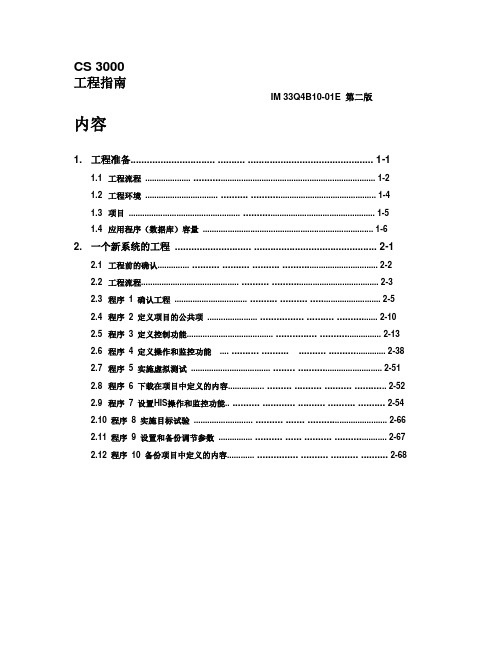
CS 3000工程指南IM 33Q4B10-01E 第二版内容1. 工程准备............................... .......... .............................................. 1-11.1 工程流程.................... .............................................................................. 1-21.2 工程环境................................ .......... ..................................................... 1-41.3 项目................................................. ........................................................ 1-51.4 应用程序(数据库)容量........................................................................... 1-62. 一个新系统的工程 ............................ ............................................. 2-12.1 工程前的确认.............. .......... .......... .......... ........................................ 2-22.2 工程流程........................................... .......... ............................................. 2-32.3 程序 1 确认工程................................ .......... .......... .............................. 2-52.4 程序 2 定义项目的公共项...................... ................ .......... ................ 2-102.5 程序 3 定义控制功能...................................... ............... ......................... 2-132.6 程序 4 定义操作和监控功能 .... .......... .......... .......... ....................... 2-382.7 程序 5 实施虚拟测试 ................................... ........ ................................... 2-512.8 程序 6 下载在项目中定义的内容................ ......... .......... .......... ............ 2-522.9 程序7 设置HIS操作和监控功能.. .......... ............ .......... .......... .......... 2-542.10 程序8 实施目标试验.......................... .......... ....... ................................. 2-662.11 程序9 设置和备份调节参数............... .......... ...... .......... ..................... 2-672.12 程序10 备份项目中定义的内容............ ............... .......... .......... .......... 2-683. 实施模拟测试后改变目标系统的工程 ...................................................... 3-1 3.1 工程操作的流程 ................................... ................... ...................................................... 3-2 3.2 程序 1 拷贝一个项目....... ................... ......................................................................... 3-4 3.3 程序 2 改变用户定义项目 ...... ................... ................... ............................................... 3-5 3.3.1 改变项目的公共项......................... ............ ............ ............ ............ ........................ 3-6 3.3.2 改变控制功能.................... ............ ............ ............ ............ ....................................... 3-7 3.3.3 改变操作和监控功能.... ............ ............ ............ ............ ............ ............................... 3-16 3.4 程序 3 实行一项虚拟测试 .............................. ....................... ......................................... 3-21 3.5 程序 4 对当前项目反映改变.. ....................... ....................... ......................................... 3-22 3.5.1 输入项目公共项.............................. ............ ............ ............ ............ .......................... 3-23 3.5.2 输入控制功能........................ ............ ............ ............ ................................................. 3-24 3.5.3 输入操作和监控功能.......... ............ ............ ............ ............ ............ .......................... 3-29 3.6 程序 5 在HIS中改变操作和监控功能..................................... ............................................ 3-33 3.7 程序 6 时是一项目标测试.............. ....................... ........................................................... 3-34 3.8 程序7 调节参数的设置和备份............ ....................... ....................... ............................. 3-353.9 程序8 项目中定义内容的备份..... ....................... ....................... ................................... 3-364. 为直接改变目标系统的工程....... ....................... ....................... ............................... 4-1 4.1 工程操作的流程 .............................. ....................... ........................................................... 4-2 4.2 程序 1 改变定义内容.......... ....................... ....................... ................................................ 4-3 4.2.1改变项目公共项..... ............ ............ ............ ................................................................. 4-4 4.2.2 改变控制功能............. ............ ............ ............ ............. ............................................... 4-5 4.2.3 改变操作和监控功能..... ............ ............ ...... ............ ............ ....................................... 4-14 4.3 程序 2 改变HIS的操作和监控的功能.. ....................... ........................... .. .......................4-19 4.4 程序 3 实施目标测试........................... ....................... .................................................... 4-20 4.5 程序 4 调节参数的设置和备份.......... ....................... ....................... ................................ 4-21 4.6 程序 5 定义过的项目内容的改变.......... ............................................. ............................ 4-22<Toc> <1. 工程准备> 1-1 1. 工程准备本章将解释对CS 3000系统实行工程过程、程序。
工程培训-PIE内训版

临时性问题临时去解决
临时性问 题指的是在一 段时间内临时 存在,而换一 段时间后有可 能会自动消失 的问题。
紧急问题第一时间处理
紧急性问 题与突发性事 故有许多相似 之处,但它们 是本质不同的 两回事。前者 虽然紧急,但 从根本上讲是 属于存在问题 的,但还没有 造成事故,而 后者已经形成 需要紧急处理 的事故、如果 不及时处理的 话后果会比较 严重。
样板/新产品时往往会有一大摞的问题,面对着诸多的问题,PIE人员根据问 题的性质如轻、重、缓、急等情况而区别对待,以确保样板/试产能尽可能顺 利进行。
发现样板生产并作好准备
生产日期、型号、生产数
调查、确认和掌握新产品的制造信息
制样当天亲临现场 观摩生产、记录问题点 接收生产问题点的通报 分析生产问题点、研究对策 通报对策措施并跟踪效果
生产改进不断持续改善
PE(或PIE)实施的改进是没有具体的目标的,但是,在一个 阶段后如果回头再看的话,有无改进的确不一样。
工艺工程变更跟进不能马虎松懈
工程变更指的是对与制造过程相关的机器、材料、方法和环 境等有目的地实施改变,以使其更好地适合于生产需要或改善制 造工艺。
工程变更一般包括如下的一些内容: ●生产材料变更,如改换材料的供方、规格、品种等; ●辅助材料变更; ●技术参数变更,如调整产品的技术指标等; ●作业方法变更,如改添加助焊剂焊锡为来加焊剂焊锡等; ●制造机器变更,如改换或修理生产机器等; ●生产仪器变更,如改换或修理生产仪器等; ●工具变更,如改换或修理生产用的工具等; ●生产场所变更,如调换或新开生产场所等; ●现场环境变更,如改变生产现场的温湿度、太阳光照、污染等:
实现同一加工目的, 通常存在着多种不 同的方法和程序。
- 1、下载文档前请自行甄别文档内容的完整性,平台不提供额外的编辑、内容补充、找答案等附加服务。
- 2、"仅部分预览"的文档,不可在线预览部分如存在完整性等问题,可反馈申请退款(可完整预览的文档不适用该条件!)。
- 3、如文档侵犯您的权益,请联系客服反馈,我们会尽快为您处理(人工客服工作时间:9:00-18:30)。
内部资料,注意保密
32
软件调测
项目实例——配置脚本
SoftX3000的配置(SoftX3000V3R003) 增加硬件信息 增加功能和协议数据 增加本局数据 增加计费数据 增加媒体网关数据 配置信令数据 增加路由和字冠数据 增加中继数据 配置用户数据 配置中继承载数据 MRS6100的配置(V100R002) 硬件数据配置 基本数据配置
内部资料,注意保密
8
第1章 工程准备
第1节 主要工作 第2节 相关流程 第3节 相关文档
第4节 项目实例——工程准备
内部资料,注意保密
9
工程准备
需要的文档
《NGN产品勘测报告》、 《XX产品勘测指导书》 《NGN工程安装 客户准备指导书》 《NGN工程手册》(M-07设计方案修改申请单)、(M-04 货物问题反馈表)、(M-23安装环境检查表)(M-03工程 进度计划表) 《NGN产品工时定额标准》 《NGN工程 数据准备指导书》 《NGN工程 配电与接地准备指导书》 《NGN工程设计中(英)文模板》
内部资料,注意保密
3
第1章 工程准备 第2章 工程实施 第3章 工程交付 第4章 开局实例任务说明
内部资料,注意保密
4
第1章 工程准备
第1节 主要工作 第2节 相关流程 第3节 相关文档
第4节 项目实例——工程准备
内部资料,注意保密
5
工程准备
主要工作
出差准备(总部工程师) 了解合同信息 了解货物备货、发货、到货、分发情况 了解现场情况 软件版本提供情况 人员到位情况 数据准备 制作工程施工方案 工前协调会
33
内部资料,注意保密
软件调测
项目实例——配置脚本
UMG8900的配置(V100R003) 配置硬件数据 配置媒体网关控制数据 配置IP承载 配置信令 SessionEngine2200的配置 配置HRP 配置代理 AMG5320/IAD2000的配置 配置设备固定IP 地址及网关 配置MG 接口数据 普通接入用户业务配置
相关文档
流程:《开工协调会操作指导书》 输出:《工程手册》——《开工协议书》(M-01) 、《开工 协调会议纪要 》(M-02)
内部资料,注意保密
19
第2章 工程实施
第1节 开工 第2节 硬件安装 第3节 软件调测
第4节 初验
第5节 割接
内部资料,注意保密
20
硬件安装
主要工作
29
内部资料,注意保密
软件调测
公司流程文件
《开箱验货、货物管理及移交指导书》 《工程技术问题管理流程》 《客户问题管理流程》 《工程质量检查流程》
内部资料,注意保密
30
软件调测
需要的文档
《NGN工程 局端设备组网指导书》 《NGN系统数据设定规范》 《NGN工程手册》(M-18调测记录表)、(M19计费确认 报告) 《质量检查标准》
内部资料,注意保密
31
软件调测
输出文档
《(客户)资料移交清单》(M-11)(除重要的硬件材料 外、相应的手册资料、服务器、BAM等软件光盘及许可协 议、服务器系列号、服务器服务号) 《软调计划》 《验收手册》(软调督导、客户随工签字) 《工程质量自检表》(M-21)(软调督导签字,事后提交 项目经理或办事处留底) 《工程备忘录》(M-13)(记录工程遗留问题,如因客户 原因没有按照公司要求施工,客户条件不具备无法进行的部 分调测但不影响功能实现) 《计费确认报告》(M-19)(软调督导、客户负责人签字 盖章)
二类业务 (建网运行后逐步开展的业务)
智能业务
三类业务 (建网后可能开展的业务) 智能业务可以较快开展起来,消息等多媒体业务,在运 营等方面还没有成熟的思路,可能要正式运营还有 较长时间。
多媒体、增值 业务
即时消息服务和统一消息 Picture Caller ID 语音与Internet相结合的业务
16
内部资料,注意保密
第1章 工程准备 第2章 工程实施 第3章 工程交付 第4章 开局实例任务说明
内部资料,注意保密
17
第2章 工程实施
第1节 开工 第2节 硬件安装 第3节 软件调测
第4节 初验
第5节 割接
内部资料,注意保密
18
开工
主要工作
按照工程实施计划,明确各部分工作负责人。建议列出工程 流程甘特图,根据关键路径合理安排工程施工。 签署《开工协议书》(M-01)、工前协调会会议纪要(要有书 面材料和客户负责人签字)。建议召开工前协调会,签署 《开工协调会议纪要 》(M-02),落实客户准备情况、落实 客户各部分工作负责人。
内部资料,注意保密
15
项目实例——工程准备
工程规划
根据《NGN工程设计中(英)文模板》进行工程设计(可选)。 根据《U-SYS NGN系统数据设定规范》使用《NGN数据规划模板》 进行数据规划。 本局数据规划
系统各部件命名规划 号首集和呼叫源规划 信令数据规划 中继数据规划 字冠路由数据规划 号码分析数据规划 媒体网关数据规划 NGN设备登录信息规划 IP地址规划 IP地址规划原则 核心层设备IP地址规划 接入层设备IP地址规划
NMS&Billing Client
PSTN (B市)
IP 承载网
E1 Trunk Uplink FE Uplink FE Uplink
UMG
SE2200(主备)
internet
系列化IAD AMG AMG 系列化 IAD
••••
A市A地
A市B地 13
内部资料,注意保密
项目实例——工程准备
项目整体介绍
本XX工程采用华为基于软交换架构的NGN网络解决方案,为XX运 营商提供分组话音、视频和各种增值业务。 在A市设置软交换设备SoftX3000一套,媒体资源服务器MRS6100 一套,通用媒体网关UMG8900一套, SessionEngine2200会话边 界控制器两套,接入媒体网关AMG5320两套,一些综合接入设备 IAD132E,以及一些多媒体终端,网络管理系统(UMS iManager2000)一套。 在B市设置通用媒体网关UMG8900一套,接入媒体网关AMG5320 两套,以及一些综合接入设备IAD132E。 在A市A楼中心机房应用设备区放一台SoftX3000软交换设备,对 全网业务终端进行控制;放一台UMG8900中继媒体网关设备,完 成与PSTN的接入和呼出;通过分组网络发展新的业务,比如:普 通语音业务、IP超市、广域CENTREX、多媒体视频业务等业务等; 本次工程IP数据承载网采用VPN模式。VPN模式即为此次XX运营 商要建设的NGN网划分为一个独立的VPN网,与原有数据网逻辑 隔离。在骨干层采用MPLS VPN,在接入通过VLAN隔离NGN业务 和数据业务,由汇聚层将接入层NGN VLAN对应到骨干NGN VPN 中。
14
内部资料,注意保密
项目实例——工程准备
业务需求
业务类别 业务类型 业务名称 国内、国际长途话音业务
本地话音业务
基本业务 一类业务 (建网运行后逐步开展的业务) 传真业务 IP Centrex业务 IP超市业务 补充业务 多媒体业务 智能业务 呼叫限制 …… 点对点多媒体通信,多方多媒体会 议业务 智能卡类业务 通用个人通信业务 …… 个人呼叫管理
内部资料,注意保密
27
软件调测
主要工作
在软件调测过程中,出现调测坏或需更换单板时,参见《开 箱验货、货物管理及移交指导书》。 在安装过程中如果遇到自己无法解决的技术问题,将问题录 入《客户问题管理系统》,并向响应中心寻求技术支持。 对《调测记录表》(M-18)的每一项内容进行内部测试, 做好记录,并由客户随工人员签字确认,为工程验收做好准 备。 建议在工前协调会上与客户明确计费情况,引导客户尽量简 化。双方对计费进行验证,验证结果要求客户签字确认,签 署《计费确认报告》(M19)。
内部资料,注意保密
6
第1章 工程准备
第1节 主要工作 第2节 相关流程 第3节 相关文档
第4节 项目实例——工程准备
内部资料,注意保密
7
工程准备
公司流程文件
ቤተ መጻሕፍቲ ባይዱ
《系统设计工程范围界定标准》 《版本管理流程》 《工程安装准备指导书》 《督导制工程操作指导书》 《客户重大项目管理流程》
内部资料,注意保密
11
第1章 工程准备
第1节 主要工作 第2节 相关流程 第3节 相关文档
第4节 项目实例——工程准备
内部资料,注意保密
12
项目实例——工程准备
XX运营商NGN网络组网示意图
XX运营商A楼
MRS6100
N2000UMS
SoftX3000
PSTN (A市)
UMG
B市
…
NGN局端组网
公司流程文件 《开箱验货、货物管理及移交指导书》 《设备安装流程》 《通信工程和维护安全生产操作指导书》
内部资料,注意保密
23
硬件安装
需要的文档
《NGN工程 配电与接地准备指导书》 《NGN工程 局端设备组网指导书》 《NGN系统硬件质量检查标准》 《NGN工程手册》(M-04货物问题反馈表 )、(M-05工程 现场周报表 )、(M-20工程质量自检表(硬件) )
NGN开局实例
ISSUE 1.0
华为版权所有,未经许可不得扩散
